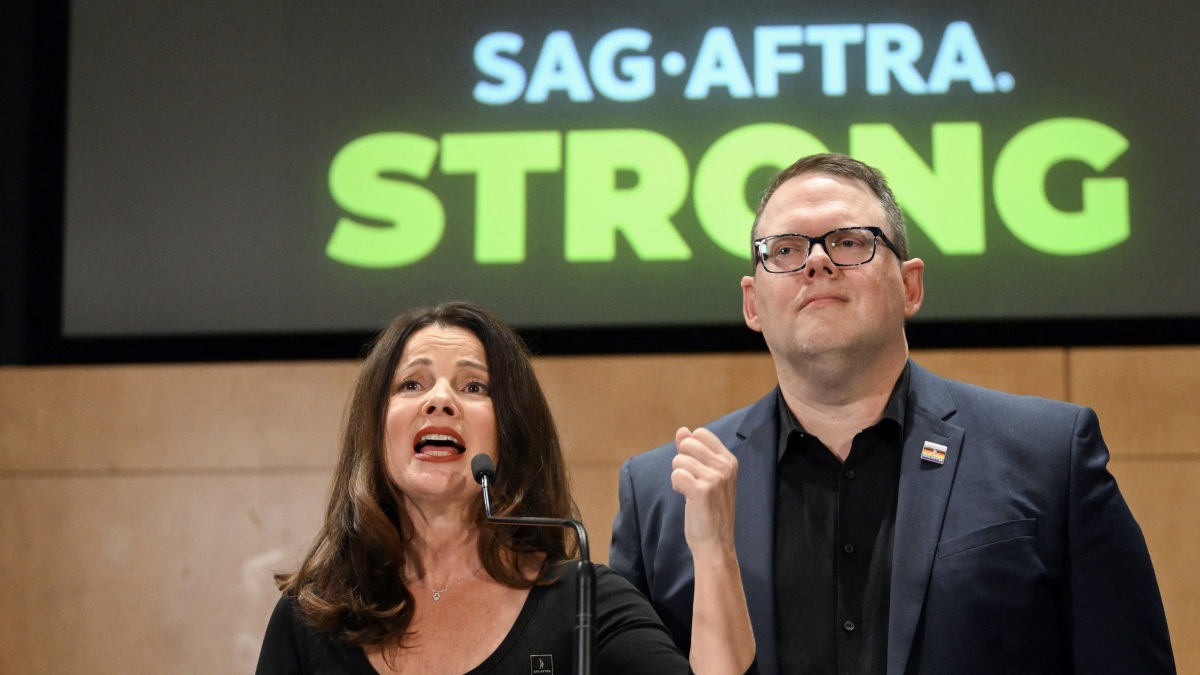

“AI Terms in SAG-AFTRA Contract Raise Concerns Among Actors”
While the SAG-AFTRA strike has concluded, apprehensions linger as members scrutinize the new contract with AMPTP, particularly regarding artificial intelligence regulations. The proposed protections outlined in the 18-page summary are deemed too vague by some actors, prompting discussions and concerns.
AI in the New SAG-AFTRA Deal:
The tentative contract acknowledges the inevitability of AI in the industry. It delineates two types of digital replicas: Employment-Based Digital Replicas (EBDRs) and Independently-Created Digital Replicas (ICDRs). Consent from actors is required for both, even posthumously, but exceptions exist. Studios can use EBDRs without consent if the content aligns with the script. ICDRs may be used without consent for projects protected by the First Amendment.
A third type, Synthetic Performers created by Generative AI, raises concerns about the potential replacement of human actors. Producers must negotiate and obtain consent if a recognizable human feature is used.
Actor Concerns and Criticisms:
Filmmaker Justine Bateman, a former SAG-AFTRA board member, expressed concerns on Twitter, emphasizing issues like payment for sequels and vague exemptions for requiring consent. Critics worry about the lack of minimum compensation for ICDRs and the potential coercion in securing consent.
Union Response:
SAG-AFTRA President Fran Drescher defended the contract, referring to critics as “naysayers.” Chief negotiator Duncan Crabtree-Ireland stated the terms were the most achievable after a lengthy strike. Concerns about the limited time for members to review the entire contract before the vote persist.
Broader Labor Implications:
The inclusion of AI terms in the contract sets a precedent beyond SAG-AFTRA, impacting labor discussions across various industries. Worries about AI replacing actors and the potential downsizing of Hollywood crews add complexity to the broader labor landscape.
As SAG-AFTRA members continue voting on the contract, the debate surrounding AI terms underscores the evolving challenges in the entertainment industry, signaling potential shifts in labor dynamics.
“Navigating the AI Horizon: Actors’ Apprehensions in the SAG-AFTRA Contract”
The curtain may have fallen on the Screen Actors Guild – American Federation of Television and Radio Artists (SAG-AFTRA) strike, but a new act unfolds with concerns lingering around artificial intelligence (AI) regulations in the union’s recent contract negotiations with the Alliance of Motion Picture and Television Producers (AMPTP). As SAG-AFTRA members cast their votes to ratify the contract by December 5, the AI terms have emerged as a focal point, prompting both scrutiny and skepticism.
The tentative SAG-AFTRA contract acknowledges the omnipresence of AI in the entertainment industry. With Hollywood studios already employing body scans of background actors, the deal outlines two distinct types of digital replicas: Employment-Based Digital Replicas (EBDRs) and Independently-Created Digital Replicas (ICDRs). EBDRs involve the performer’s direct participation in a specific project, while ICDRs are crafted from existing material without the performer’s physical involvement.
Consent, a crucial element in this AI landscape, is required for both forms of digital replicas, with the contract explicitly stating that consent persists after an actor’s demise unless otherwise specified. However, the devil lies in the details, and exceptions exist. Consent is not mandatory for the use of EBDRs if the photography or soundtrack remains substantially as scripted, performed, and/or recorded—a clause seemingly left to the studios’ discretion. Similarly, studios can utilize ICDRs without consent for projects protected by the First Amendment, encompassing uses like scholarship, satire, parody, or historical and biographical works.
The contract introduces a third category of digital performer—Synthetic Performers created by Generative AI. This innovation aims to craft entirely new performers who are unrecognizable and do not share roles with natural performers. If the name of a deceased actor is used in the creation of a Synthetic Performer, resulting in a recognizable facial feature, producers must engage in negotiations and secure consent from the actor’s estate.
Notable voices within the union, including filmmaker Justine Bateman, have raised concerns regarding the language and provisions of the contract. Bateman, a former SAG-AFTRA board member and negotiating committee participant, expressed apprehensions about compensation for EBDRs used in sequels, the absence of minimum compensation for ICDRs, and the vague exemptions for requiring consent. The contract’s approach to consent also raises questions, as studios can potentially seek alternative actors willing to provide consent if the original actor declines.
SAG-AFTRA President Fran Drescher dismissed critics as “naysayers” and “contrarians,” emphasizing the cautious optimism embedded in the AI terms. Chief negotiator Duncan Crabtree-Ireland acknowledged concerns but defended the terms as the best achievable outcome after a 118-day strike. However, concerns persist among members, especially with the limited time for a comprehensive review before the ratification vote.
Beyond the realm of SAG-AFTRA, the inclusion of AI terms in the contract reverberates as a precedent-setting moment, extending its implications to broader labor discussions. The fear of AI replacing actors and potential repercussions on Hollywood crews creates a nuanced landscape that extends beyond the realm of SAG-AFTRA.
In conclusion, as SAG-AFTRA members engage in the ratification process, the AI terms underscore the evolving dynamics of the entertainment industry, prompting a closer examination of the delicate balance between technological advancements and the protection of actors’ rights.
Note: The information is based on the latest available data and statements.
PAN Card Application Process: A Complete Guide A Permanent Account Number (PAN) Card is an…
Meet Samuel Edyme, Nickname - HIM-buktu. A web3 content writer, journalist, and aspiring trader, Edyme…
Violet & Daisy, a captivating action-comedy directed by Geoffrey Fletcher, revolves around the lives of…
MBC's latest release, the trailer for episode 5 of "Wonderful World," showcases the captivating performances…
Deadpool 3 & Wolverine Super Bowl Trailer Easter Eggs The Deadpool 3 Super Bowl trailer…
The Nagi Nagi no Mi is a Paramecia-type Devil Fruit with the unique ability to…